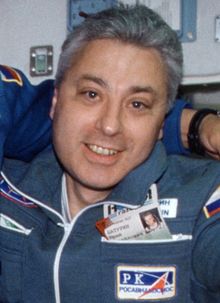Yuri Baturin
Russian - (RFSA)
Retired
Date of Birth: June 12, 1949
Age: 76
Yuri Mikhailovich Baturin (Russian: Юрий Михайлович Батурин (born 12 June 1949, Moscow, Soviet Union {now Russia})), is a Russian cosmonaut and former politician. Baturin graduated from the Moscow Institute of Physics and Technology in 1973, and is the former Assistant to the President on National Security and Secretaty of the Defense Council (1996-1998); he is also an author in constitutional law. Baturin was also a cosmonaut who flew on two missions. His first spaceflight, sometimes called Mir EP-4, was launched with the spacecraft Soyuz TM-28 13 August 1998, and landed with Soyuz TM-27. He was a Research Cosmonaut for this mission, which lasted for 11 days 19 hours 39 minutes. His second spaceflight was ISS EP-1, which was launched with the spacecraft Soyuz TM-32 on April 28, 2001, and landed with Soyuz TM-31. This mission was notable as carrying to first paying space tourist Dennis Tito. For this mission he was designated a Flight Engineer; the mission lasted for 7 days 22 hours and 4 minutes.
Soyuz U | Soyuz TM-27
Russian Federal Space Agency (ROSCOSMOS) | RussiaBaikonur Cosmodrome, Republic of Kazakhstan
Jan. 29, 1998, 4:33 p.m.
Status: Success
Mission:
Soyuz TM-27 was the 35th mission and the 25th long-duration expedition to Mir space station. It was also a part of the US/Russian Shuttle-Mir Program. The mission began on January 29, 1998, 16:33:42 UTC, launching Commander Talgat Musabayev, Flight Engineer Nikolai Budarin and Research Cosmonaut Léopold Eyharts into orbit. They docked with Mir two days later. During their stay there, cosmonauts performed several EVAs and various scientific experiments in medicine, biotechnology, Earth sciences etc. Station crew was visited by several Progress resupply spacecrafts, STS-91, and welcomed aboard Soyuz TM-28 with the next expedition crew. The mission concluded with a safe landing back on Earth on August 25, 1998, 05:24:44 UTC.
Low Earth OrbitSoyuz-U | Soyuz TM-28
Russian Federal Space Agency (ROSCOSMOS) | RussiaBaikonur Cosmodrome, Republic of Kazakhstan
Aug. 13, 1998, 9:43 a.m.
Status: Success
Mission:
Soyuz TM-28 was the 37th mission and the 26th long-duration expedition to Mir space station. The mission began on August 13, 1998, 09:43:11 UTC, launching Commander Gennady Padalka, Flight Engineer Sergei Avdeyev and Research Cosmonaut Yuri Baturin into orbit. They docked with Mir two days later. During their stay there, cosmonauts performed several EVAs and various scientific experiments in medicine, biotechnology, Earth sciences etc. Station crew was visited by several Progress resupply spacecrafts, and welcomed aboard Soyuz TM-29 with the next expedition crew. The mission concluded with a safe landing back on Earth on February 28, 1999, 02:14:30 UTC.
Low Earth OrbitSoyuz-U | Soyuz TM-31
Russian Federal Space Agency (ROSCOSMOS) | RussiaBaikonur Cosmodrome, Republic of Kazakhstan
Oct. 31, 2000, 7:52 a.m.
Status: Success
Mission:
Soyuz TM-31 began Expedition 1 by carrying 3 cosmonauts and astronauts to the International Space Station. Russian Commander, cosmonaut Yuri Gidzenko alongside Flight Engineer, Sergei Krikalev and Flight Engineer/Spaceflight Participant William Shepherd launched aboard the Soyuz spacecraft on October 31, 2000, 07:52:47 UTC. They docked with the station two days later. During their stay there, crew performed first maintenance and repair works, carried out first experiments and conducted several EVAs. They were also visited by several Progress resupply spacecrafts and STS-97 and STS-98 crews, and welcomed aboart STS-102 with the next expedition crew. Expedition 1 returned with STS-102, landing safely back on Earth on 21 March 2001, 07:33:06 UTC.
Low Earth OrbitSoyuz-U | Soyuz TM-32
Russian Federal Space Agency (ROSCOSMOS) | RussiaBaikonur Cosmodrome, Republic of Kazakhstan
April 28, 2001, 7:37 a.m.
Status: Success
Mission:
Soyuz TM-32 was a visiting mission to ISS, which carried 3 cosmonauts and astronauts. Russian Commander, cosmonaut Talgat Musabayev alongside Flight Engineer, Yuri Baturin and Flight Engineer/Spaceflight Participant Dennis Tito launched aboard the Soyuz spacecraft on April 28, 2001, 07:37:20 UTC. They docked with the station two days later. During their stay there, crew assisted Expedition 2 members in station work. Soyuz TM-32 crew returned aboard Soyuz TM-31, landing safely back on Earth on May 6, 2001, 05:41:28 UTC.
Low Earth OrbitThe Roscosmos State Corporation for Space Activities, commonly known as Roscosmos, is the governmental body responsible for the space science program of the Russian Federation and general aerospace research. Soyuz has many launch locations the Russian sites are Baikonur, Plesetsk and Vostochny however Ariane also purchases the vehicle and launches it from French Guiana.
Long March 3B/E
Fengyun-4C
Launch Complex 2 (LC-2) - Xichang Satellite Launch Center, People's Republic of ChinaChina's geostationary meteorological satellite program FY-4 (Feng Yun 4) is the second generation of chinese geostationary meteorological satellites.
Long March 8A
SatNet LEO Group 17
Commercial LC-1 - Wenchang Space Launch Site, People's Republic of ChinaA batch of 9 Low Earth Orbit communication satellites for the Chinese state owned SatNet constellation operated by the China Satellite Network Group.…
Soyuz 2.1a
Obzor-R No.1
43/4 (43R) - Plesetsk Cosmodrome, Russian FederationNote: Assignment of payloads to this launch is uncertain. The Russian Obzor-R satellite is a planned X-band radar earth observation satellite desi…
LVM-3 (GSLV Mk III)
BlueBird Block 2 #1
Satish Dhawan Space Centre Second Launch Pad - Satish Dhawan Space Centre, IndiaAST SpaceMobile’s Block 2 BlueBird satellites are designed to deliver up to 10 times the bandwidth capacity of the BlueBird Block 1 satellites, requi…
Long March 12A
Demo Flight
Long March 12A Pad - Jiuquan Satellite Launch Center, People's Republic of ChinaFirst test launch of CASC/SAST’s Long March 12A rocket, with a dummy payload. The rocket’s 1st stage attempted to land on a landing pad about 300 km …



